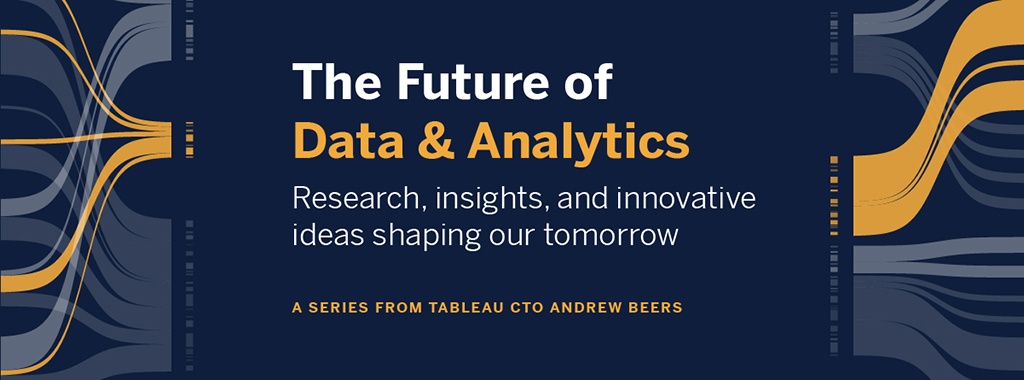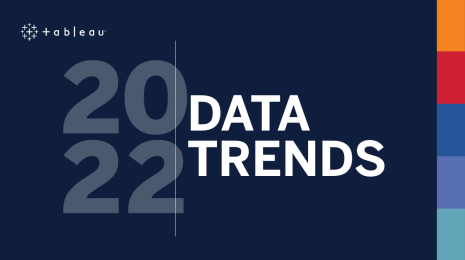The role of data in overcoming misinformation and building trust
The Future of Data & Analytics is a new series by Tableau CTO Andrew Beers, where he connects with industry leaders, researchers, and innovators to discuss the biggest questions shaping the future of data and analytics.

The past year has been rife with significant challenges, and there are many questions about how to best move forward. This compelled me to carve out a space where leaders, researchers, and innovators could share their perspective on forces shaping our future. As Tableau's CTO, I have the privilege of leading a world-class research and human-centric innovation team. Together, we’ve spent more than a decade examining the intersection between data, technology, and culture.
We believe that how people choose to use data and analytics today will influence decisions that shape our future—from the way we work to how we innovate. Our goal for this new series is to discuss research, emerging technologies, and insightful ideas that drive innovation. This first post will focus on trust—specifically, how we can use data to ensure we are getting reliable information rather than alternative facts.
Facts vs. ‘fake news’
In a year burdened by fears and uncertainties on a global scale, data-driven insights and its harmful cousin—misinformation—both flourished. Controversies fueled by rampant misinformation and conspiracy theories flared up in public discussions, distracting from real progress. Sadly, data alone is not enough to shut them down. For instance, when COVID became part of daily conversation, it was hard to ignore the wide range of interpretations, skepticisms, and scrutiny of the data. People wondered if the dangers of this disease were exaggerated or if there was any truth in discredited information.
According to a recent article in Fortune, experts who study misinformation say several changes must be made to combat the rise of data being unintentionally misused or misinterpreted. For one, they suggest there needs to be a public educational effort to help people discern real news from fake news. Technology companies have to also do a better job at curbing and controlling the spread of misinformation. And the general public must genuinely question what they see and read, rather than merely seek to confirm what they hope is true. Until that happens, misinformation will continue to proliferate unabated.
The correct use and interpretation of data has never been more important when it comes to helping people understand what is real and what is not. Organizations that value data and teach their people how to properly use it will have a greater advantage over those that do not.
In data we trust
At Tableau, it’s important to us that we do our part. My team is looking at more ways to build more trust and transparency in data and analytics without adding to the chaos. New innovations can help, but we don't want to rely on technology alone to simply separate facts from fiction.
People bring a wealth of diverse experiences, creative ideas, and critical and ethical judgment to data and analytics. And our ability to think critically and ethically about data is more important than ever. So I’ve asked experts in various disciplines to share their perspectives on trust in data. Specifically, how should we look at data around COVID-19 to ensure we are getting reliable information versus alternative facts? And what can this teach us about using data to make critical decisions?
__________________
Francis X. Campion, MD, FACP
Principal Lead, Digital Health, The MITRE Corporation
During the pandemic, the scientific and public health community was forced to make decisions on the best available data. This is a process we physicians use every day in the care of individual patients - making treatment decisions on the use of medicines and surgery, always weighing the potential benefit and harm.
During COVID-19, we’ve been forced to compress the scientific process into a very short time frame and accelerate change in the way we do science and public policy. This requires collaboration and trust. We built new coalitions such as the COVID-19 Healthcare Coalition - rapidly and with few constraints - to harness the goodwill and talent of people and institutions to solve problems together based on the best available data.
Going forward we expect that the health delivery system and public health systems will be more closely tied together by rapid-cycle data initiatives on a grand scale. We expect the use of AI and ML on very large datasets made possible through these types of collaboration. We expect the discovery of new treatments and creation of new drugs, vaccines, and the reuse of existing therapies for novel purposes to be accelerated by these advances in data science.
__________________
Yoav Schlesinger
Principal, Ethical AI Practice, Salesforce
Data is at the core of every decision that’s currently being made to push us through the pandemic — whether it is identifying hotspots and predicting hospital capacity or deploying vaccines to the areas most critically in need. Though we knew it before, we’ve all been newly reawakened to the need for data tools to deliver the right information at the right time to ensure equitable and responsible COVID-19 response. But when the tools or data at our fingertips suffer from bias or systemic inequity, the impacts ripple widely.
As an example: Hospital systems across the country have been leaning on efforts to develop AI systems to predict how likely their COVID-19 patients are to fall severely ill or even die. But the datasets on which those models are trained have, by and large, failed to include diverse sets of patients. That puts some of the models at high risk of contributing to biased and unequal care for COVID-19, which has already taken a disproportionate toll on Black and Indigenous communities and other communities of color.
We need to answer big questions about the underpinnings of the information we’re looking at - is the data legitimately sourced and, if so, where did it come from? Who assembled it? What assumptions underlie it? Is it accurately presented? How will we ensure the actions we take based on our interpretation of those data will minimize inequity, rather than exacerbate it? We are at a moment when we need to fundamentally reevaluate our relationship with data and establish new norms around the collection, use and misuse of data.
__________________
Dr. Anamaria Crisan
Senior Researcher, Tableau
One hundred and fifty years ago John Snow and Florence Nightingale turned to data to answer a critical question: “Why are people dying?” They independently developed innovative approaches to data collection and visualization in a race against a deadly outbreak of Cholera and declining, but fatal, sanitary conditions endured by soldiers. Their findings led them to enact interventions that stopped the spread of disease and ultimately founded the practices of modern public health. Today, their examples act to galvanize a new generation of disease detectives to understand and respond to unseen threats in order to save countless lives.
But the process from data to action is not seamless. Both Snow and Nightingale struggled to understand the underlying vector of contagion in the data they collected. Around them existed a variety of theories, some reasonable, some irrational, about the source and spread of disease. To find the signal in this noise, they worked tirelessly to probe and test their data before finally acting. We face similar challenges today as scientists and community leaders work to put together different pieces of the COVID-19 pandemic puzzle. Now, as then, there exist a variety of facts, some valid and some less so. But today we can help people cut through the noise, by creating platforms to distribute both data and visualizations widely. By empowering people to share and engage with data, we provided a critical service to combat intentionally misleading claims and rally our communities to work together.
The challenges we face in this pandemic will unfortunately be present in the next. It is critical that we work to continuously innovate our approaches to combat both the spread of disease and misinformation.
__________________
Relaterade berättelser
Subscribe to our blog
Få de senaste Tableau-uppdateringarna i din inbox.












